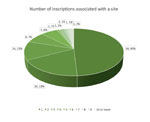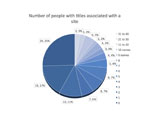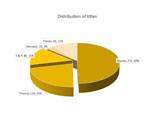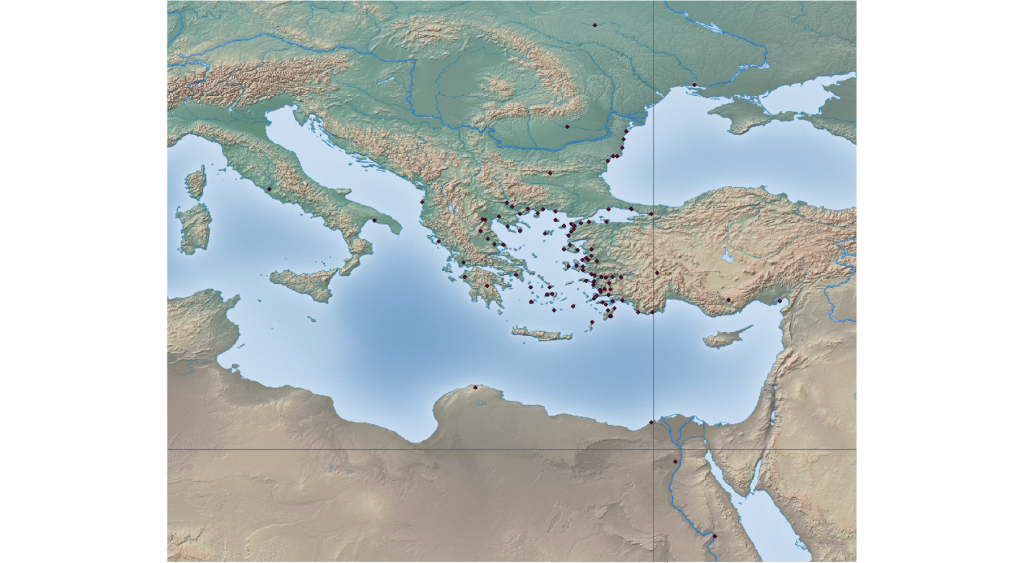The Epigraphic Record
a. Introduction
The data for this study come from 236 inscriptions, a form of information in which the Samothracian cult is especially rich; 171 of these come from the island itself. These provide our sole access to our informants, e.g. the participants in the Samothracian network. The inscriptions are most abundant for the 2nd century BC through the 1st century AD. Dates are usually determined by letter form. These constitute a record of nearly 950 individuals who enjoyed ritual or civic status which linked them to the island, as well as the names of 109 cities from which they came. These are neither Ptolemies nor great generals, but fairly ordinary men and women who traveled to the island to become initiates, serve as theoroi at the annual festival, or become proxenoi for their home towns.
The task of epigraphic publication is to complete the stone, which is often broken, heavily worn, out of context, full of abbreviations, and written in an idiosyncratic local alphabet. Dating systems varied wildly from one Greek city to another, and the great majority of the Samothracian stones are datable only by letter form: some of the Latin inscriptions name individuals known from the historical record, or offer a consular year, but these are by far the minority. Some stones, moreover, include additions by different hands at presumably different dates. Few of the Samothracian inscriptions offer iconography, narrative or explanation; none are poetic; the task justifiably may be compared to reading a series of badly damaged phone books. There are, in addition, caveats regarding the place names listed on Samothracian stones. Some are so badly worn that they are restored only with hesitation; others were associated with more than one ancient city; others are assigned geospatial coordinates only with hesitation, as they have not been identified archaeologically.
b. Publication history
Samothracian inscriptions have been the object of study and restoration since Cyriacus of Ancona first set foot on the island in 1444, and the bibliography on individual stones frequently has roots into the 19th century, when Conze, Fredrich and other German scholars traveled the islands of the Northern Aegean. Four modern publications are fundamental in bringing all of the material together. Carl Fredrich published 113 Samothracian inscriptions in Inscriptiones Graecae (XII.8) in 1909. In 1960, P.M. Fraser published 91 inscriptions as part of the Samothracian publication series (Samothrace 2.1); these consist of all the inscriptions found on the site between 1938 and 1957, as well as some selections from Fredrich’s IG. In 1984, Susan Cole published a study of the rites as a religious and historical phenomenon, integrating literary, archaeological and epigraphic evidence. She adds to Fraser and Fredrich the inscriptions from sites in Asia Minor, the Black Sea, and the Aegean islands which are relevant to Samothracian initiation and civic honors. In 2008, Nora Dimitrova brought together all of the inscriptions relevant to initiation and theoria, presenting both previously unpublished stones and selections from Fraser, Fredrich and Cole. A total of 233 inscriptions emerge as the data base from which we proceed.
c. The population on the stones
The 950 names on our Samothracian stones generally occur only once: they record a moment in time when that individual was present, became a priest, or performed a ritual act. The long list of individual visits does not yield the kind of information about differing frequency and intensity which is the core of network analysis. Those factors can be determined, however, for the cities for which these individuals were representatives. Between 1 and 40 names are preserved for each city in the Samothracian network, representing individuals who connected their homes to the island through a range of rituals and civic offices. Our study uses these individuals as proxies for the places from which they came. This approach has the unfortunate effect of immediately disqualifying nearly half of our population, as only 545 of the 950 names are associated with known sites. These connections, moreover, are reconstructed from relatively few inscriptions: 54 sites, or 49% of the total, have only one inscription, another 20, 18%, have only two. Out of the total number of inscriptions, 29, or 25% of them, offer names only, with no indications of title – mystes, theoros, or proxenos. Only three sites have between 30 and 40 people; over 50% of the sites have two, one, or no names at all associated with them. These give an indication of the potential to pursue the role of weak ties, and cast light on the longevity and adaptability of the Samothracian network.
The following pie charts visually represent the data discussed above. Click on a chart to view it larger:
| Number of inscriptions associated with a site | Number of people with titles associated with a site | Distribution of titles |
 |
 |
 |
From Stones to Space: Creating The ArcGIS Database
Since the promise of the rites is safe movement through space, situating these loci in real space is the first step to analyzing the promise. Longitude and latitude for each of the 109 place names which emerge from the Samothracian stones have been identified with the help of the Barrington Atlas (R.J.A. Talbert, Princeton University Press 2000). These were used to create the database shown here (slide 9). These cities constitute the known boundaries of the Samothracian sea, within which travel was safer for those who were initiates in the rites. The power of GIS as a research tool extends far beyond cartography: it is a database which provides storage, querying and integration of discrete data types within a geospatial framework. Data to be included in this project for the sites include:
- the epigraphic data linking the site to the Samothracian rites
- local ritual practice, particularly other gods linked to maritime safety or who also appear on Samothrace
- local economy
The benefits of this program will include:
- visualization: our ability to sail the course along Samothracian affiliated sites
- the ability to determine lines of sight and range of visibility from one Samothracian-connected site to another
- analogies to MapQuest: with the economic and the ritual data combined, we will be able to conduct queries into:
- what economic benefits could accrue from sailing along ‘Samothracian routes’
- how the ‘safest’ route related to the ‘richest’ routes
- how the reach of the Samothracian gods coincided with other ritual networks
From Stones to Networks: SNA from a Hellenistic epigraphic record
a. Introduction
The reduction of risk through theoria and proxenia relied on human interactions, as Samothracian affiliates met, communicated and cooperated. Social Network Analysis (SNA), focused on frequency, intensity, and pattern of contacts, offers a route to gauge these meetings, and thus the actual effectiveness of this network. It relies on the quantification of data, turning names into numbers and places into nodes characterized by greater or lesser engagement. This is very different from the close, critical reading of individual stones which is the hallmark of epigraphic publication. It also highlights the extent to which we are dealing with only a fraction of the total data, itself a random and partial survival from antiquity. Our approach to sampling is inclusive and conservative – inclusive because we are tolerant of a significant degree of uncertainty due to the low quality of some of the inscriptions, and conservative because including these potential sources of error in the statistical analyses will enhance the significance of any patterns we observe. While the numbers from Samothrace are so meager as to be inadequate by standards of modern network analysis, they are well within the range of studies conducted with materials from the ancient Mediterranean, and support investigation of key network concepts including centrality, directionality, and the strength of weak ties. Our efforts will also bring the island into ongoing conversations about the potential for network studies in archaeological contexts in the Mediterranean and beyond (Knappett 2013; Brughmanns 2010; Malkin 2011).
The most informative stones in terms of network analyses are 28 ‘block grants’, which begin with a preamble declaring that during the administration of a certain eponymous Samothracian magistrate, called a ‘Basileus’, the listed individuals were granted proxenia and theoria (Cole 1984: 39; Fraser 1960: 62) The stones are organized into columns, in which a city name, centered, is followed by one to four or more names of individuals who represented that city. The grants are all on wall blocks of approximately the same height, 0.35 m, and so are assumed to come from the same building; they are dated between the 2nd centuries BC and AD. As this block size seems small for the monuments inside the sanctuary, this may have been a building from within the city walls, an area which remains unexcavated. This building, on analogy with structures in Delos and Delphi, would have served for many generations as the city’s place for advertising its grants.
a. Reading social behavior on the island: theoria
The value of the block grants in network terms is that these city representatives may be understood to have been together on the island at the same time, interacting in the context of the festival (de Ligt and de Neeve 1988). The duties and privileges specific to theoria and proxenia varied from one city state and one historical period to another: some details of what was entailed in Samothrace’s theoria may be reconstructed from literary, epigraphic, and iconographic sources. The Greek term ‘theoros’ refers to a range of ideas associated with viewing something – as a sightseer, a civic official, an inquirer at an oracle, or as an official representative to a festival (Dimitrova 2008: 9-21; Rutherford 1995: 276-92; Perlman 1000; Rutherford 2000). Plutarch refers to the Samothracian festival as a panegyricus, an assembly or festival and specifies, of Voconius, that he was present both for initiation and for the celebration of the festival (Lucullus 13.1-2). A third century BC inscription from Iasos describes the duties of Samothracian theoria in very generic terms: the theoroi are to perform a sacrifice, make an offering of first fruits, and observe events taking place in the sanctuary – τὴν παραγεγενημένην εἰς τὸ ἱερὸν (Dimitrova 2008: 74; Habicht 1994). Marconi has argued that the archaising frieze on the Hall of Choral Dancers represents a performance of chorus of young women at the annual festival; Kowalzig and Rutherford affirms the association between theoria and chorality on Samothrace (Marconi 2010; Kowalzig 2007; Rutherford 2007). The possibility for the festival to include theatrical performance is suggested by honors which Samothrace granted to poets and playwrites for works composed in celebration of Kadmos, Harmonia and Dardanos, central figures in Samothrace’s mythic past (Rutherford 2007). The date of the Samothracian festival remains uncertain, though it is clear that it was not the time for initiations – this is an important contrast to Eleusis, the great mysteries in Attica, where initiation into the mysteries occurred only during the great annual festival (Cole 1984: 39, 48; Dimitrova 2008: 248-49; Fraser 1960: 89-91; Lewis 1959: 104; Lehmann 1969b: 11; Vian 1974: 19; Hemberg 1950: 108). While some individuals are clearly identified as both initiates and theoroi, we cannot be confident that every theoros was also an initiate.
b. Reading social behavior away from the island: proxenia
Proxenia, a frequent addition to Samothracian theoria, has been identified since Weber as a counter to the piracy which was a perennial threat in Mediterranean waters. A proxenos, broadly defined, served the interests of another state in his home city; the privileges associated with it varied through the 700 years and the widely scattered locations in which it is known in the ancient Greek world (Marek 1984). Its relevance to sea travel arises from the customs of piracy in the ancient Mediterranean, as a history of offenses, real or fabricated, was frequently the rationale for piratical seizure of ships, crew and cargo. By offering legal resource for compensation for these offenses, proxenia undercut the justification for such seizure and so effectively reduced the practice of piracy. Proxenia inscriptions may also detail further benefits for seagoing ships, including the right to sail into and out of ports without interference, freedom from port taxes, and access to local assemblies. While the Samothracian inscriptions which link proxenia to theoria do not detail these privileges, three proxenia inscriptions found within the city walls of Samothrace do (BCH 86, 1962, 270-74, no. 2; IG XII(8) 155; IG XII(8) 151. These mention the privileges of ateleia, freedom from taxes and fees; access to city councils and citizens; the right of sailing into and out of the harbor without paying taxes or fees, in times of war, times of peace, and in pursuit of commercial exchange. They also specifically ensure asylia, protection from the seizure which was the modus operandi of ancient piracy. The inscriptions refer explicitly to ‘the other proxenoi’ when outlining the terms of proxeny, suggesting the applicability of these benefits to all who enjoyed this honor from the island; IG XII(8) 155 offers these privileges not only to the recipient, but to his descendants for perpetuity. In Odessos on the Black Sea, an inscription granting these benefits to that city’s honorees was set up in the local temple of the Samothracian gods (IGBR I no. 42). The combination of proxeny with theoria would invest these benefits with the authority of the gods widely recognized for their protection of maritime passage.


